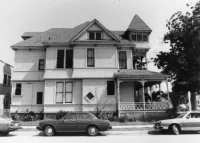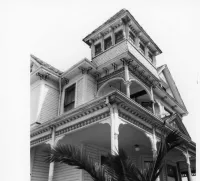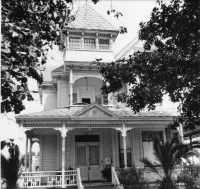Share what you know,
and discover more.
Share what you know,
and discover more.
Nov 16, 1979

-

- Charmaine Bantugan
Miller and Herriott House (Miller and Herriot Tract House) - National Register of Historic Places
Statement of Significance The house isthe oldest surviving example of tracthouses built by speculative developers for speculative investment purposes in the Miller/Herriott Tract. The Miller/Herriott enterprise was formed to dispose of unsold portions of the Harper and Nie s Tracts after the disasterous collapse of the 1887 land boom. For a ""spec"" house, the Miller & Herriott house contains a surprising number of innovative features. The combination of contiguous spaces (80% of the first floor) and large bay window glass areas and high ceilings, create an air of spaciousness and openness that is unique for this period. After the collapse of the Los Angeles* 188? land boom, developers attempted to sell remaining parcels by speculative construction of dwellings with sufficient character to attract leary buyers. This house is one of the oldest such houses constructed by Miller & Herriott, a development firm that survived the collapse of the land boom. The Miller & Herriott Tract successfully sold the remainder of the Harper and Nies Tracts between l88? and I896. Scarcity of official records has hindered documentation of the property, but County Assessor's files date the residence at I890. City directories reveal that the property was not only built for speculation but that it was also purchased for speculative purposes. NohgiiiMof the property's first three owners actually resided in the house. The house has had 2? owners in 89 years. It has survived virtually every ethnic ownership and occupancy imaginable in Los Angeles history, having housed from one person to nine families. It has been converted from single unit dwelling to boarding house, apartment building, and back' to single family dwelling. The house is the oldest of 7 remaining Victorians on West 2?th Street. Four similar houses in the same block have already been demolished. Although attributed to Joseph Cather Newsom by the USC Historic Site Survey Team, it is more likely to be an early work of Bardbeer & Ferris who designed several other large Victorians in the immediate vicinity. The most important value of the building is its survival as a reminder of Southern Califor'^ia nia's first generation of tract houses in the truest sense of the term. The fact that it was built for a multitude of potential buyers rather than a specific occupant, makes it an excellent example of a building designed for the tastes and values of the time.
Miller and Herriott House (Miller and Herriot Tract House) - National Register of Historic Places
Statement of Significance The house isthe oldest surviving example of tracthouses built by speculative developers for speculative investment purposes in the Miller/Herriott Tract. The Miller/Herriott enterprise was formed to dispose of unsold portions of the Harper and Nie s Tracts after the disasterous collapse of the 1887 land boom. For a ""spec"" house, the Miller & Herriott house contains a surprising number of innovative features. The combination of contiguous spaces (80% of the first floor) and large bay window glass areas and high ceilings, create an air of spaciousness and openness that is unique for this period. After the collapse of the Los Angeles* 188? land boom, developers attempted to sell remaining parcels by speculative construction of dwellings with sufficient character to attract leary buyers. This house is one of the oldest such houses constructed by Miller & Herriott, a development firm that survived the collapse of the land boom. The Miller & Herriott Tract successfully sold the remainder of the Harper and Nies Tracts between l88? and I896. Scarcity of official records has hindered documentation of the property, but County Assessor's files date the residence at I890. City directories reveal that the property was not only built for speculation but that it was also purchased for speculative purposes. NohgiiiMof the property's first three owners actually resided in the house. The house has had 2? owners in 89 years. It has survived virtually every ethnic ownership and occupancy imaginable in Los Angeles history, having housed from one person to nine families. It has been converted from single unit dwelling to boarding house, apartment building, and back' to single family dwelling. The house is the oldest of 7 remaining Victorians on West 2?th Street. Four similar houses in the same block have already been demolished. Although attributed to Joseph Cather Newsom by the USC Historic Site Survey Team, it is more likely to be an early work of Bardbeer & Ferris who designed several other large Victorians in the immediate vicinity. The most important value of the building is its survival as a reminder of Southern Califor'^ia nia's first generation of tract houses in the truest sense of the term. The fact that it was built for a multitude of potential buyers rather than a specific occupant, makes it an excellent example of a building designed for the tastes and values of the time.
Nov 16, 1979
Miller and Herriott House (Miller and Herriot Tract House) - National Register of Historic Places
Statement of SignificanceThe house isthe oldest surviving example of tracthouses built by speculative developers for speculative investment purposes in the Miller/Herriott Tract. The Miller/Herriott enterprise was formed to dispose of unsold portions of the Harper and Nie s Tracts after the disasterous collapse of the 1887 land boom. For a ""spec"" house, the Miller & Herriott house contains a surprising number of innovative features. The combination of contiguous spaces (80% of the first floor) and large bay window glass areas and high ceilings, create an air of spaciousness and openness that is unique for this period.
After the collapse of the Los Angeles* 188? land boom, developers attempted to sell remaining parcels by speculative construction of dwellings with sufficient character to attract leary buyers. This house is one of the oldest such houses constructed by Miller & Herriott, a development firm that survived the collapse of the land boom. The Miller & Herriott Tract successfully sold the remainder of the Harper and Nies Tracts between l88? and I896.
Scarcity of official records has hindered documentation of the property, but County Assessor's files date the residence at I890. City directories reveal that the property was not only built for speculation but that it was also purchased for speculative purposes. NohgiiiMof the property's first three owners actually resided in the house.
The house has had 2? owners in 89 years. It has survived virtually every ethnic ownership and occupancy imaginable in Los Angeles history, having housed from one person to nine families. It has been converted from single unit dwelling to boarding house, apartment building, and back' to single family dwelling.
The house is the oldest of 7 remaining Victorians on West 2?th Street. Four similar houses in the same block have already been demolished. Although attributed to Joseph Cather Newsom by the USC Historic Site Survey Team, it is more likely to be an early work of Bardbeer & Ferris who designed several other large Victorians in the immediate vicinity.
The most important value of the building is its survival as a reminder of Southern Califor'^ia nia's first generation of tract houses in the truest sense of the term. The fact that it was built for a multitude of potential buyers rather than a specific occupant, makes it an excellent example of a building designed for the tastes and values of the time.
Posted Date
Mar 20, 2022
Historical Record Date
Nov 16, 1979
Source Name
United States Department of Interior - National Park Service
Source Website
Delete Story
Are you sure you want to delete this story?












